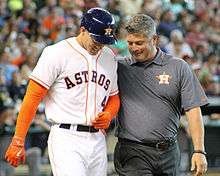Athletic trainer

An athletic trainer is a certified and licensed health care professional who practices in the field of sports medicine. Athletic training has been recognized by the American Medical Association (AMA) as an allied health care profession since 1990.[1]
As defined by the Strategic Implementation Team of the National Athletic Trainers' Association (NATA) in August 2007:[2]
"Athletic training is practiced by athletic trainers, health care professionals who collaborate with physicians to optimize activity and quality of life for patients both of the physically active and sedentary population. Athletic training encompasses the prevention, diagnosis[3] and intervention of emergency, acute and chronic medical conditions involving impairment, functional limitations and disabilities."
To become an athletic trainer one must have a degree from an accredited professional level education program and then sit for and pass the Board of Certification (BOC) examination. Each state then has their own regulatory agencies that control the practice of athletic training in their state. Most states (42) require an athletic trainer to obtain a license in order to practice in that state, 5 states (Colorado, Hawaii, Minnesota, Oregon, West Virginia) require registration, 2 states (New York, South Carolina) require certification, while California has no state regulations on the practice of athletic training.[4] Areas of expertise of certified athletic trainers include:
- Apply protective or injury-preventive devices such as tape, bandages, and braces
- Recognize and evaluate injuries
- Provide first aid or emergency care
- Develop and carry out rehabilitation programs for injured athletes
- Plan and implement comprehensive programs to prevent injury and illness among athletes
- Perform administrative tasks such as keeping records and writing reports on injuries and treatment programs
Services rendered by the athletic trainer take place in a wide variety of settings and venues, including actual athletic training facilities, primary schools, universities, inpatient and outpatient physical rehabilitation clinics, hospitals, physician offices, community centers, workplaces, and even the military. Emerging settings for athletic training include surgical fellowship opportunities.[6]
Educational programs
The Commission on Accreditation of Athletic Training Education (CAATE) oversees the curriculum standards of all accredited Professional (entry level) and all of the institutions.[7] The standards dictate the content of both didactic and clinical practice portions of the educational program. Content areas include:[8]
- Risk Management and Injury Prevention
- Pathology of Injuries and Illnesses
- Orthopedic Clinical Examination and Assessment
- Medical Conditions and Disabilities
- Acute Care of Injuries and Illnesses
- Therapeutic Modalities
- Conditioning and Rehabilitative Exercises
- Psychosocial Intervention and Referral
- Nutritional Aspects of Injuries and Illnesses
- Healthcare Administration
- Professional Development and Responsibility
- Healthcare Professional Development and Responsibility
Post-professional programs
There are several post-professional master's-level athletic training programs. These programs are for credentialed athletic trainers who desire to become scholars, researchers, and advanced practice professionals. Schools with post-professional athletic training masters programs include:[9] A.T. Still University, University of Hawaii at Manoa, Illinois State University, Indiana State University, Indiana University, University of Kentucky, Michigan State University, Western Michigan University, University of North Carolina Chapel Hill, Ohio University, University of Oregon, California University of Pennsylvania, Temple University, Old Dominion University, University of Toledo, University of Virginia, University of Missouri, Weber State University, University of Michigan.
There are doctoral programs in athletic training, each with different curricular emphasis. Athletic training program in doctoral education is offered by the University of Idaho, A.T. Still University, and Indiana State University.
Treatment population and settings
Athletic trainers treat a broad population, from the amateur and professional athlete to the typical patient in need of orthopaedic rehabilitative care. The NATA describes typical clients groups as,
- Recreational, amateur and professional athletes
- Individuals who have suffered musculoskeletal injuries
- Those seeking strength, conditioning, fitness and performance enhancement
- Others designated by the physician.
Services rendered by the athletic trainer take place in a wide variety of settings and venues. These may include:
- Athletic training clinics
- Schools (K-12, colleges, universities)
- Outpatient Rehabilitation Clinics
- Hospitals
- Physician offices
- Community facilities
- Workplaces (commercial and government)
- Military installations and veteran medical facilities
- Professional sport organizations
See also
References
- ↑ Delforge GD, Behnke RS. The history and evolution of athletic training education in the United States. J Athl Train. 1999;34(1):53–61. PMC free article PubMed
- ↑ "Strategic implementation team defines profession". NATA News (12/2007): 14. 2007.
- ↑ http://www.bocatc.org/images/stories/resources/rdpa6_content_outline.pdf
- ↑ http://www.bocatc.org/state-regulation/map
- ↑ Bureau of Labor Statistics, U.S. Department of Labor, Occupational Outlook Handbook, 2016-17 Edition, Athletic Trainers, on the Internet at http://www.bls.gov/ooh/healthcare/athletic-trainers.htm (visited September 1, 2016).
- ↑ Hunt, Valerie (2006). "Education continues to evolve: post-professional education expands". NATA News (1/2006): 14–19.
- ↑ "About CAATE". Retrieved 24 January 2013.
- ↑ "What is an Athletic Trainer?". The Board of Certification Website. 2007.
- ↑ http://www.nata.org/education/educational-programs/accredited-programs